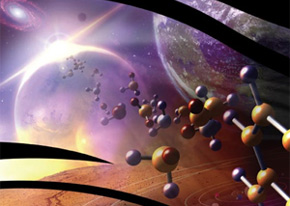

The objective of this virtual network is to help integrate the scientific community in Brazil (Nasa)
The objective of this virtual network is to help integrate the scientific community in Brazil.
The objective of this virtual network is to help integrate the scientific community in Brazil.

The objective of this virtual network is to help integrate the scientific community in Brazil (Nasa)
By Elton Alisson
Agência FAPESP – The Brazilian astrobiology community has welcomed a new virtual network. This network will bring together institutions and researchers from different states who are involved in this multidisciplinary field dedicated to studying the origin, evolution, distribution and future of life on Earth and possibly beyond. The Brazilian Astrobiology Network (RBA) was launched at the end of May by researchers at the Astrobiology Research Center at the Universidade de São Paulo (NAP-Astrobio/USP).
The network is targeted to researchers, professors, and undergraduate and graduate students who work in astrobiology research, teaching or communication in Brazil or abroad. One of the aims of this network is to organize and help integrate the scientific community in the astrobiology field in Brazil.
“Astrobiology is a very broad area—the result of an interface between astronomy, biology, chemistry, geology and atmospheric sciences, among other disciplines—in which researchers from different regions of Brazil are active but still work separately,” commented Fabio Rodrigues of NAP-Astrobio, one of the initiators of the project.
“RBA’s goal is to promote integration between these researchers in order to facilitate dissemination of actions, such as events and research cooperation opportunities. In this manner, it will be possible to increase the impact of studies conducted in the country,” he said.
According to Rodrigues, one of the difficulties inherent in identifying researchers active in astrobiology is that many of them study topics related to this field of knowledge but without using this nomenclature.
There are, for example, researchers who study the formation and detection of prebiotic molecules (which existed before the emergence of life) on planets and in the interstellar medium but who do not mention astrobiology as a keyword in their scientific articles or in the descriptions of their research on summaries available on the internet.
“The idea is for astrobiology researchers to enter the network’s site to establish contacts with colleagues and for this interaction to result in research collaborations and other joint initiatives, such as promoting events, launching courses and identifying new lines of research,” said Rodrigues.
According to Rodrigues, the plan is for the network to be a means of identifying the main needs of researchers in the area and, if there is interest, the first step in the creation of a formal body for the research community in Brazil, such as a Brazilian Society of Astrobiology.
A scientific committee comprising scientists from around the world, many with experience in organizing societies and astrobiology networks in their respective countries, was formed to create the RBA. Among the committee members are Lynn Rothschild, a researcher at NASA; Neil Banerjee, president of the Canada Astrobiology Network; Antigona Segura, of the Mexican Astrobiology Society; and Worlf Geppert, of the Nordic Network of Astrobiology.
The scientific committee will have the mission of evaluating the RBA’s course and the fulfillment of the objectives. “These researchers will help us to look at the RBA and to think about topics in astrobiology research that should be stimulated in Brazil, taking into account the country’s priorities,” said Rodrigues.
Some lines of research explored by astrobiology researchers around the world are the following: astrochemistry; prebiotic chemistry and the origins of life; planetary formation and exoplanets; ancestral land and the first fossils; geologic, atmospheric and hydrologic cycles on Earth and other planets; evolution; spatial exploration; and understanding life in extreme environments on Earth.
In December 2011, researchers from the USP’s Institute of Astronomy, Geophysics and Atmospheric Sciences (IAG) hosted the São Paulo Advanced School of Astrobiology—Making Connections (Spasa 2011), under the auspices of FAPESP’s São Paulo School of Advanced Sciences program. The event brought together 160 researchers, lecturers and students from Brazil and abroad.
Some of the indirect results of the school were the October 2012 publication of a special edition of the International Journal of Astrobiology, based on the conferences held at the event.
The contacts made during the event made it possible for NAP-Astrobio to become an associate member of the NASA Astrobiology Institute. NAP-Astrobio is also an international member of the European Astrobiology Networks Association. “All this gives us the possibility to expand and also turn the RBA into an international member of the astrobiology networks of other countries,” said Rodrigues.
Republish
The Agency FAPESP licenses news via Creative Commons (CC-BY-NC-ND) so that they can be republished free of charge and in a simple way by other digital or printed vehicles. Agência FAPESP must be credited as the source of the content being republished and the name of the reporter (if any) must be attributed. Using the HMTL button below allows compliance with these rules, detailed in Digital Republishing Policy FAPESP.





